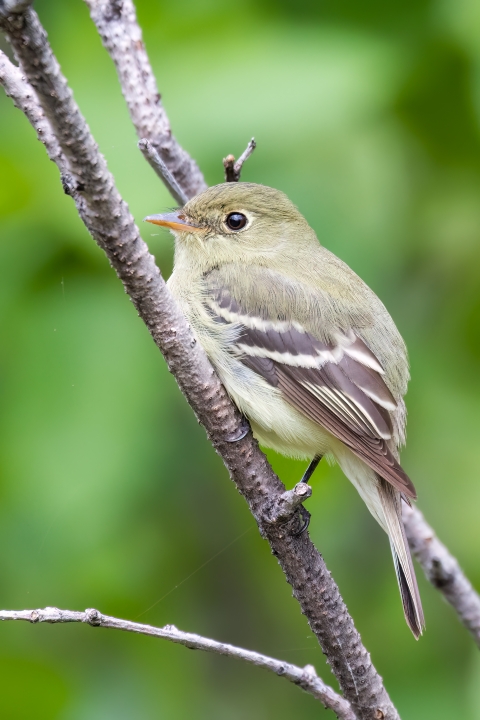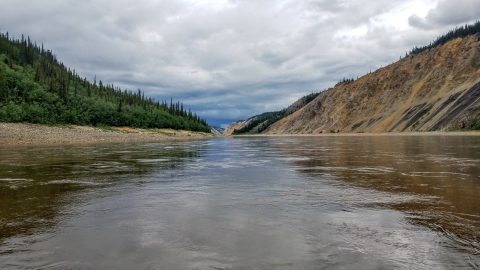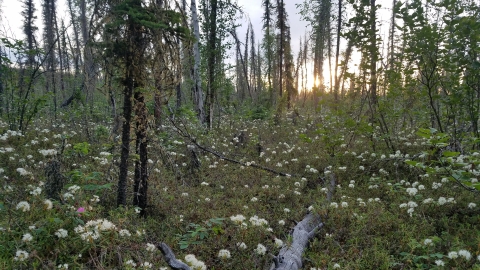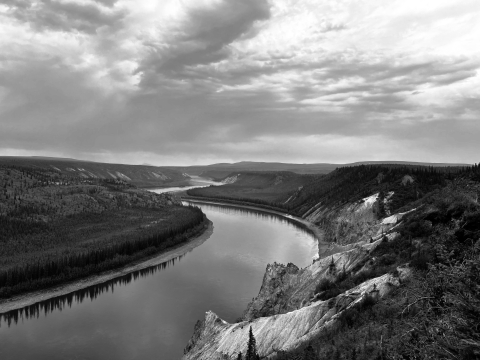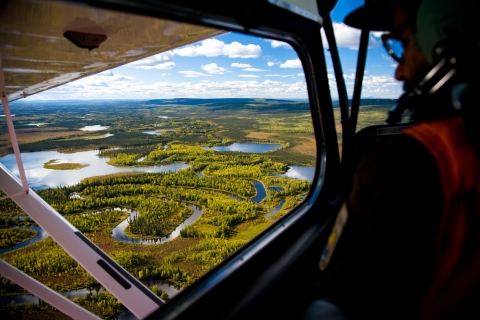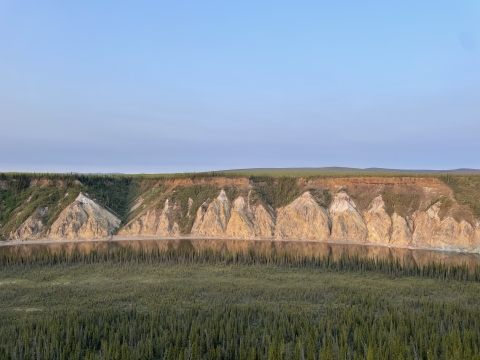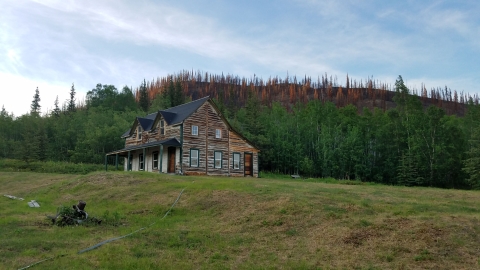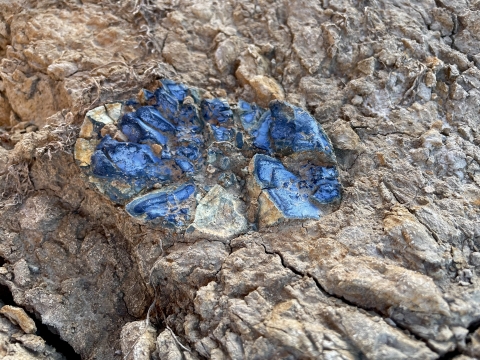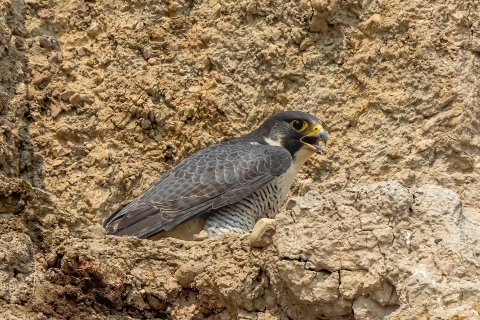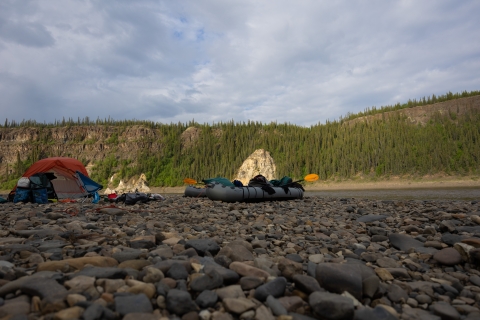Swathed in bug netting and waterproof waders, Paul Leonard stepped out onto the edge of a sunlit, rocky bluff overlooking the Porcupine River. At 9 am, he was already six hours into a grueling workday in a remote corner of the Arctic National Wildlife Refuge in Alaska.
“Did you hear that?!” he exclaimed. “Downriver, on that steep slope. There!”
“Che-lek,” the harsh and clipped song called back. “Che-lek.” And then a second call, across the river. Two yellow-bellied flycatchers, songbirds that winter far to the south in Central America, at home in the Arctic for their summer nesting season in the far northern boreal forest.
Ravens wheeled overhead while ducks dove in the river below. Tiny kinglets, weighing no more than a AAA battery, chorused from the dwarf black spruce trees. A peregrine falcon scolded out from a cliff-side nest somewhere nearby.
And everywhere, the mosquitos and black flies thickly buzzed, an insect feast for carnivorous dragonflies and abundant bird life.
The Arctic National Wildlife Refuge is a summer paradise for birds. With five different ecological biomes, vast expanses of ideal nesting habitat, and a *very* healthy insect population, birds travel here annually from six different flyways, from as far away as New Zealand and Africa. For Paul, the supervisory wildlife biologist at Arctic Refuge, it is also a dream for avian monitoring.
Except for one tiny, logistical hiccup: there are no roads. And the complication: this nursery for birds covers more than 19 million acres.
In many areas of Alaska, rivers provide the best access to roadless landscapes. They are a travel corridor for both wildlife and people navigating across millions of acres.
Alaska delivers a challenge for bird surveys
The annual North American Breeding Bird Survey (BBS) in early summer is one of the most widespread and consistent ways to monitor bird species in the world. The survey relies on a series of roadside stops where observers look and listen for birds during the early morning hours. This survey network across the continent helps us better understand how different bird species are doing – and when they are in trouble.
Blackpoll warblers breed in northern coniferous forests. They have lost over 90% of their population since the 1970s. Learning more about these birds at all of their life stages is critical to our understanding of what’s driving this population loss.
The survey only works in a small area of Alaska, however. Most of the state is only accessibly by boat, plane, or on foot, which holds true for the Interior Alaskan boreal forest. Unfortunately, birds that nest and raise chicks in the boreal forest face the second steepest population decline among all the biomes in North America. Read more about some of the boreal forest songbirds that breed in Alaska.
The Alaska Landbird Monitoring Survey (ALMS) is one solution to the problem of the enormous information gap in Alaska’s roadless areas. It is also an arduous and sometimes daunting task: surveyors must navigate to a random series of points far from roads or trails to listen and observe for birds. The terrain for each survey location can be densely vegetated, steep, full of bears and bugs, and formidably difficult to access and navigate.
The challenges of observing at the Porcupine River ALMS are worthwhile to Paul, however, in the face of drastically declining bird populations and a lack of information:
“I think the eastern Arctic region is egregiously under-sampled,” he explained, “but this region is important to understand how climate change climate change
Climate change includes both global warming driven by human-induced emissions of greenhouse gases and the resulting large-scale shifts in weather patterns. Though there have been previous periods of climatic change, since the mid-20th century humans have had an unprecedented impact on Earth's climate system and caused change on a global scale.
Learn more about climate change is driving range expansion and contraction for birds.”
The Porcupine River ALMS site may be among the most challenging in Alaska. Just getting there requires ingenuity and flexibility. Changing conditions like water levels, wildfire smoke, and the logistical hurdle of landing small planes on infrequently visited gravel bars can alter plans in a moment. Few planes fly in this area of Alaska, and there are limited backup options to re-fuel or find alternative landings.
This year, Paul and his teammate arrived by boat from Fort Yukon, a couple hundred miles downstream. They nearly missed the scheduled pickup by plane a few days later when strong headwinds pushed against their small rafts.
Flying over the Interior boreal forest and wetlands of Alaska, southwest of the Porcupine River area at Kanuti Refuge.
Traveling an ancient river of Beringia
On that sunny morning as Paul recorded the birds he could hear and see in the thick forest, the Porcupine River curled below, cutting against the edge of an ancient landscape.
Fifty thousand years ago, this was one of the few areas of North America to remain unglaciated during the peak of the last ice age: part of a strip of open country known as Beringia. The river grew out of streams and headwaters in Canada as a two-mile thick ice sheet melted and overflowed lakes. It ultimately reached the mighty Yukon River, linking the northeastern Arctic to the far western coast of Alaska. It flows through what is now the southeastern corner of Arctic National Wildlife Refuge.
The river has long been a travel corridor and important place for both people and wildlife. Gwich’in Athabascan communities continue to access hunting and fishing areas that lie between the villages of Alaska Natives near Arctic Refuge and villages of First Peoples in Canada. Trappers and prospectors also used the river during the 1800s for travel and trade. Old village sites, cabins, and a Hudson Bay trading post remain along the banks.
Even salmon travel this way: king and chum salmon migrate up to spawning grounds in Canada from the Pacific Ocean in an incredible long-distance feat over hundreds of miles. Along with the Tanana River to the south, the Porcupine is one of the most important streams for fall chum salmon in the Yukon River watershed.
It is also the namesake for the Porcupine Caribou Herd that winters near the headwaters and crosses the river annually on their migration to the Arctic coastal plain to calve.
As the river crosses into Alaska, large bluffs rise along the shore, carved out by water over time. The layers of rock and silt hold a history of climate changes spanning millions of years, including mammoth bones and old redwood trees.
This is some of the best nesting habitat for peregrine falcons in Alaska. It is also the beginning of the Porcupine ALMS observation points, a survey made possible because the river provides access.
"The Arctic Refuge sampling locations (the Porcupine River and the nearby Colleen River) were chosen to represent an interior boreal forest ecosystem with a minimal human footprint," Paul described. "These sites also balance some of the logistical complications of surveying this part of the country. Both sites are accessible by major rivers during the survey period and provide (mostly) reliable fixed-wing landing locations."
Remote but connected
“In the short term, I have a very simple goal of making sure this survey effort can have a future at Arctic Refuge,” Paul reflected. “I think there is more to learn, more to uncover.”
The promise of learning more about these birds extends far beyond the remote landscape of a far northern refuge.
“By gaining an understanding of these species during the summer, it connects us to the many networks of places, people, and problems that these birds encounter at other periods in their life histories,” Paul explained. “One of the great things about studying migratory birds is that they provide a wonderful example of how important it is to work together.”
The Porcupine River provides connection as well: between villages and countries, across climate epochs, and along cultural histories. And, through the winged creatures that call it home, the river connects the Arctic Refuge with the rest of the world.

